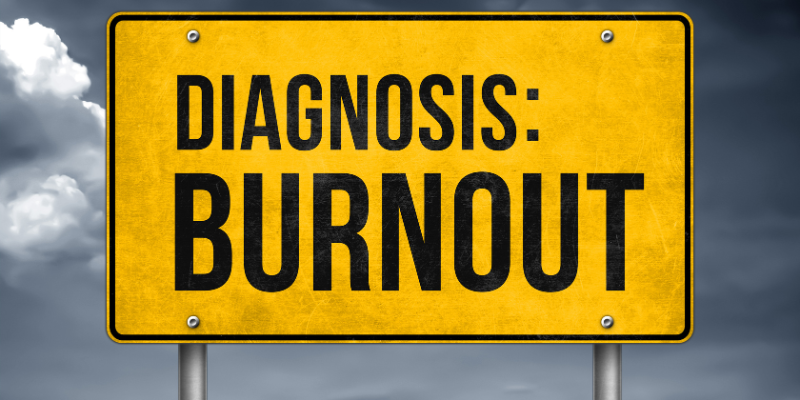
By
Diyaa Mani
May 21, 2024
Updated
May 29, 2024
Employee burnout has become common in today's fast-paced, high-pressure work environments. According to Dr. Christina Maslach, a Professor of Psychology and core researcher at the Healthy Workplaces Centre of UC Berkeley, burnout is defined as a state of "chronic stress that leads to exhaustion, cynicism, detachment, and feelings of ineffectiveness."
Burnout not only damages one's well-being and career; it can also diminish motivation, leaving individuals feeling drained and leading to phenomena such as quiet quitting.
Fortunately, there is a light at the end of the tunnel. By recognising the signs of burnout and taking proactive measures, you can overcome it and cultivate resilience.
In this article, we'll examine the risk of burnout, identify warning signs, and provide actionable coping strategies, from prioritising self-care to establishing healthy boundaries to help you lead a more balanced professional life:
- What are the symptoms of burnout at work?
- What are the common causes of burnout?
- Impact of burnout on individuals
- Coping strategies to conquer burnout
- How to set boundaries in the workplace
- Seeking support when experiencing burnout
- Airswift: Your key to unlocking a fulfilling and balanced career

What are the symptoms of burnout at work?
Studies show that workplace burnout is a serious problem with significant consequences. Employees experiencing burnout have a 57% increased risk of workplace absence, 180% increased risk of developing depressive disorders, and 84% increased risk of Type 2 diabetes. Burnout can also impair cognitive processes essential for daily work activities.
Recognising the signs of burnout, whether they show up physically, emotionally, or behaviorally, is key. This awareness empowers you to intervene early before reaching a breaking point.
Understanding these common warning signs equips you with the tools to detect burnout early and take proactive steps towards prevention and recovery.
The key signs of burnout include:
Physical symptoms of burnout
- Gastrointestinal problems
- High blood pressure
- Poor immune function and frequent illness
- Recurring headaches
- Sleep disturbances
- Feelings of physical and emotional depletion
Emotional/mental symptoms of burnout
- Concentration and focus issues
- Depressed mood, feelings of worthlessness
- Loss of interest or pleasure in work and activities
- Suicidal ideation
- Feeling helpless, trapped, and defeated
- Feeling detached/alone in the world
- Having a cynical/negative outlook
- Self-doubt
- Procrastinating and taking longer to get things done
- Feeling overwhelmed
- Anxiety
- Detachment
- Emotional exhaustion and listlessness
- Low mood
Behavioural signs of burnout
- Reduced performance and productivity
- Withdrawal from social activities and relationships
- Increased reliance on unhealthy coping mechanisms like substance abuse
- Fantasies about escaping work or responsibilities
- Irritability and difficulty coping with everyday stressors
- Coping with normal stressors may become overwhelming
- Frequent illnesses due to lowered immune system function
- Excessive drive/ambition leading to burnout
- Neglecting self-care and displacement of conflict as signs of burnout

What are the common causes of burnout?
Recognising and understanding the various signs and symptoms associated with burnout will enable us to implement targeted strategies for prevention and recovery.
Work-related stress causing burnout
Your work environment can often be a major catalyst for burnout, as you grapple with heavy workloads, tight deadlines, and constant pressure to excel.
This sense of responsibility and workplace stress can lead to feelings of powerlessness and a perception of being trapped in an unending cycle of expectations.
This can be exacerbated by poor work-life balance, long hours and an inability to disconnect from work. When you cannot find time for rest, relaxation, and personal pursuits, exhaustion and elevated stress levels can spiral into burnout.
Personal factors causing burnout
While the work environment is a significant factor, one's habits can contribute to burnout. For example, if you often set very high standards for yourself, you might feel constantly dissatisfied or as if you're never quite meeting your goals.
Also, not setting clear personal boundaries can lead individuals to take on more responsibilities than they can comfortably manage.
Environmental factors causing burnout
The broader environmental and societal context can also influence the prevalence of burnout. For example, a workplace with a highly competitive atmosphere might make it harder for employees to speak openly about their challenges.
This can leave them feeling isolated and unsupported, leading to hopelessness and a lack of motivation.
Moreover, societal expectations to always be productive, successful, and available can intensify these challenges, making it difficult for individuals to "switch off" and take necessary breaks.

Impact of burnout on individuals
The intricate interplay of work-related challenges, personal tendencies, and environmental influences can culminate in burnout.
The repercussions of burnout transcend the individual, impacting various facets of their personal, professional, and social well-being.
How does burnout impact individuals personally?
On a personal level, burnout can lead to a significant decrease in quality of life as individuals struggle with physical and emotional exhaustion, compromised mental health, and strained relationships.
The constant stress and depletion associated with burnout can make it increasingly difficult for individuals to engage in self-care, nurture their connections, and maintain a sense of overall well-being. Dr. Jody Carrington, a renowned expert on resilience, notes that burnout can seep into every facet of your life, leaving you feeling disconnected and unfulfilled.
How does burnout impact individuals professionally?
In the professional realm, burnout can harm an individual's job satisfaction, productivity, and performance. Burnout's emotional and cognitive toll can cause decreased motivation, increased errors, and disengagement. Jennifer Moss, the author of "The Burnout Epidemic," explains that burnout can also impair decision-making, problem-solving, and overall work quality.
This can have far-reaching consequences for the individual and the organisation, as decreased productivity and increased risk of mistakes can lead to financial losses and reputational damage.
How does burnout impact individuals socially?
Beyond the personal and professional spheres, burnout can also impact an individual's social well-being. As individuals withdraw from social activities and engagement, burnout can contribute to feelings of isolation.
This can intensify the emotional and mental strain, creating a vicious cycle that undermines an individual's overall sense of connection and belonging. Resilience advocate Kaleb Dahlgren emphasises that "burnout can impact your relationships, community, and ability to thrive in all aspects of your life."

Coping strategies to conquer burnout
Given the multifaceted nature of burnout and its far-reaching consequences, it is crucial to address this issue proactively and holistically.
In the following section, we will explore a range of coping strategies and interventions that can help you cultivate healthier, more sustainable coping mechanisms.
Self-care practices for individuals experiencing burnout
Self-care is not selfish – it's essential for maintaining the energy and focus needed to thrive in our personal and professional lives.
Dr. Amit Sood - Founder and Executive Director of the Global Centre for Resiliency and Wellbeing
One of the foundational pillars of combating burnout is implementing self-care practices that nurture physical and mental well-being.
This may include adopting tailored exercise routines, incorporating balanced nutrition, and establishing healthy sleep habits to ensure optimal rest and recovery.
Here are some actionable self-care practices that individuals can implement to combat burnout:
Incorporate exercise routines into your schedule
- Engage in physical activities you enjoy, whether walking, yoga, swimming, or any other form of exercise.
- Tailor your exercise routine to your schedule and preferences to make it sustainable.
- Aim for at least 30 minutes of physical activity daily, even if broken into shorter sessions.
Ensure that you eat a balanced, nutritious diet
- Focus on consuming a diet rich in whole, nutrient-dense foods to support your energy levels and overall health.
- Ensure you stay hydrated by drinking plenty of water throughout the day.
- Avoid relying on unhealthy coping mechanisms like excessive caffeine or comfort foods.
Establish healthy sleep habits
- Establish a consistent sleep schedule, aiming for 7-9 hours of quality sleep per night.
- Create a relaxing bedtime routine to help you wind down and prepare for sleep.
- Limit screen time and exposure to blue light before bed to improve sleep quality.
Stress management techniques for individuals experiencing burnout
Developing a toolkit of stress management strategies can empower individuals to navigate the challenges of burnout better and maintain a sense of control.
Jennifer Moss - Author, The Burnout Epidemic
In addition to self-care practices, developing effective stress management techniques can be instrumental in building resilience and reducing the anxiety associated with burnout. This may involve incorporating practices that promote calmness and mitigate physiological chronic stress responses.

Here are some actionable steps for stress management techniques that individuals experiencing burnout can implement:
Adopt mindfulness practices as a daily routine
- Engage in mindfulness exercises such as meditation, deep breathing, or yoga to cultivate present-moment awareness and reduce stress.
- To increase mindfulness and reduce stress, practice mindfulness in daily activities like eating, walking, or even doing the dishes.
Meditate daily to reduce burnout
- Adopt meditation as a regular practice to promote relaxation, focus, and emotional regulation.
- Start with short sessions (5-10 minutes) and gradually increase the duration as you become more comfortable with the practice.
Perform breathing exercises to calm and de-stress
- Implement breathing exercises to promote calmness and mitigate physiological stress responses.
- Practice deep, slow breaths in through the nose and out through the mouth, focusing on the sensation of the breath.
Perform progressive muscle relaxation to unwind
- Practice progressive muscle relaxation by tensing and relaxing different muscle groups.
- Start with your toes and work up to your head, holding each muscle group for a few seconds before releasing.
Visualisation
- Practice visualisation by imagining yourself in a peaceful, relaxing environment.
- Visualise yourself in a place where you feel safe, calm, and relaxed, such as a beach or a forest.
Learn time management to increase effectiveness
- Prioritise tasks and manage your time effectively to reduce feelings of overwhelm and increase productivity.
- Break down large tasks into smaller, manageable chunks, focusing on one task at a time.
How to set boundaries in the workplace
Boundaries are not just about saying no – they're about saying yes to the things that truly matter and preserving your well-being.
Dr. Jody Carrington - Psychologist and best-selling author
Setting clear boundaries is essential for effectively protecting your time and energy. Establishing boundaries creates a sense of control over your workload and commitments, preventing feelings of overwhelm and exhaustion.
Here are some actionable steps for setting boundaries in the workplace:
Identify your values and priorities
Consider what holds utmost significance to you in both your personal and professional life. Evaluate which tasks and obligations resonate with your core values.
Communicate your boundaries clearly
Openly communicate your boundaries to your managers and colleagues. Use "I" statements to clearly express your needs, such as "I need to leave the office by 6 p.m. today to have dinner with my family."Learn to say "no" with confidence
Politely decline any requests that go beyond your capabilities. Offer alternative solutions or propose delegating tasks to others when necessary.Prioritise self-care activities
Schedule time for activities that recharge and rejuvenate you, such as exercise, hobbies, or relaxation practices. Protect this time and not let work or other obligations infringe on it.
Disconnect from work
Set clear boundaries around work hours and refrain from checking emails or taking calls outside those times. Consider turning off work-related notifications on your devices during non-work hours.Review and adjust your boundaries as needed
Regularly assess whether your boundaries are still serving you or need to be modified.
Be willing to adapt your boundaries as your circumstances or needs change.

Seeking support when experiencing burnout
Finally, the importance of seeking support from professionals, peers, and loved ones cannot be overstated in the context of burnout.
Here are some actionable steps for seeking support when experiencing job burnout:
Reach out to your Employee Assistance Program (EAP)
Many employers offer EAP services that provide confidential counselling and support for employees dealing with burnout. Utilise these resources to get professional help addressing the underlying issues and developing personalised coping strategies.
Engage in therapy or counselling
Consider working with a licensed therapist or counsellor, either through your EAP or privately, to explore the root causes of your burnout. A mental health professional can help you develop healthy coping mechanisms and provide guidance on managing stress and restoring work-life balance.
Join a support group
Seek out local or online support groups for individuals experiencing burnout. Sharing your experiences and learning from others who understand what you're going through can provide a sense of community and mutual support.
Confide in trusted friends, family, or colleagues
Open up to people you trust about what you're going through. They may be able to offer a listening ear, emotional support, and practical advice on managing the challenges you're facing.
Seek guidance from a mentor or trusted advisor
Reach out to someone you look up to or who has faced similar challenges, like a seasoned colleague or a respected industry figure. Their experience can provide invaluable perspectives, guidance, and encouragement tailored to your situation.
Utilise online resources and communities
Visit online platforms, discussion boards, and virtual communities tailored to assist individuals coping with burnout. These resources serve as valuable hubs of knowledge, practical coping techniques, and a supportive network of individuals who can empathise with your experiences.

Airswift: Your key to unlocking a fulfilling and balanced career
In conclusion, it is essential to recognise the signs of burnout early and implement effective coping strategies to prevent its negative impacts. Mental health and well-being are paramount to achieving a work-life balance. Let this serve as a reminder to prioritise self-care, reach out for help when necessary, and cultivate a supportive environment that values and promotes mental wellness.
At Airswift, we understand that a balanced approach to work and life is essential for overall success and fulfilment.
Our team is dedicated to matching you with organisations that foster a nurturing environment, prioritise employee well-being, and support professional advancement. Browse through our available opportunities and discover the latest jobs in technology and engineering that bring out the best in you.
